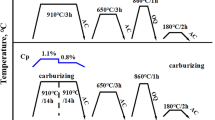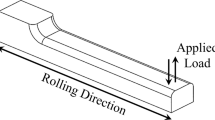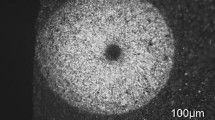Abstract
The high cycle fatigue resistance of carburized AISI E9310 steel has been investigated for two different levels of surface retained austenite and surface residual stress. Fatigue specimens were carburized to a case depth of 1.9 mm with a surface carbon content of 1.0 wt pct carbon. This treatment gave surface retained austenite and surface residual stress levels of 56 vol pct and -595 MPa (-86 ksi), respectively. Half of these specimens were then given a refrigeration treatment which lowered the surface retained austenite level to 31 vol pct and raised the surface residual stress level to —760 MPa (-110 ksi). High cycle fatigue tests showed that the specimens with the higher surface retained austenite level had the best high cycle fatigue resistance. X-ray diffraction studies showed that both treatments of steel exhibited decreasing retained austenite and residual stress levels with cycling. Light microscopy and electron fractography showed that fracture apparently initiated in the carburized case, although the exact initiation site could not be determined. A nalysis of the results suggests that the poorer high cycle fatigue resistance for the steel with the low retained austenite results from a degradation of the fatigue resistance of the case material.
Similar content being viewed by others
References
Metals Handbook, vol. 2, 8th Ed., pp. 100–101, American Society for Metals, 1964.
G. Parrish:The Influence of Microstructure on the Properties of Case-Carburized Components, pp. 72–84, American Society for Metals, 1980.
1979 Annual Book of ASTM Standards, part 10, p. 587, American Society for Testing and Materials, 1979.
B. D. Cullity:Elements of X-ray Diffraction, pp. 391–96, Addison-Wesley, 1959.
SAE Handbook Supplement, Residual Stress Measurement by X-ray Diffraction—SAE J784a, pp. 19–20, Society of Automotive Engineers, 1971.
R. H. Richman and R. W. Landgraf:Metall. Trans. A, 1975, vol. 6A, pp. 955–63.
M.A. Balter and I. S. Dukarevich:Met. Sci. Heat Treat., 1971, vol. 13, pp. 729–32.
K. D. Jones and G. Krauss:Heat Treatment ’79, pp. 188–93, The Metals Society/ASM, 1980.
G. Parrish:op. cit., p. 75.
L. S. Castleman, B. L. Averbach and M. Cohen:Trans. ASM, 1952, vol. 44, pp. 240–57.
G. Dieter:Mechanical Metallurgy, p. 432, McGraw-Hill, 1976.
T. Bell and D. H. Thomas:Metall. Trans. A., 1979, vol. 10A, pp. 79–84.
M. Motoyama:Trans. SAE, 1976, vol. 85, pp. 2300–05.
C. E. Feltner and P. Beardmore: ASTM STP 467, p. 77, American Society for Testing and Materials, 1970.
L. Magnusson and T. Ericsson:Heat Treatment ’79, The Metals Society/ASM, pp. 202–06.
C. A. Apple and G. Krauss:Metall. Trans., 1973, vol. 4, pp. 1195–1200.
N. Lazaridis, F. J. Worzala and B. I. Sandor:Mater. Sci. Eng., 1977, vol. 30, pp. 23–31
R. W. Landgraf and R. H. Richman: ASTM STP 569, pp. 130–44, 1975.
G. Dieter:op. cit., p. 430.
Author information
Authors and Affiliations
Additional information
M. A. Panhans, formerly Graduate Student, Marquette University
Rights and permissions
About this article
Cite this article
Panhans, M.A., Fournelle, R.A. High cycle fatigue resistance of AISI E9310 carburized steel with two different levels of surface retained austenite and surface residual stress. J. Heat Treating 2, 54–61 (1981). https://doi.org/10.1007/BF02833074
Issue Date:
DOI: https://doi.org/10.1007/BF02833074




